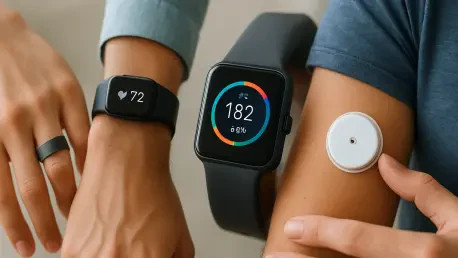Imagine a world where a simple wristband could alert a doctor to a patient’s irregular heartbeat before it becomes a crisis, or where a smartwatch helps someone with diabetes manage their condition with real-time glucose insights. Wearable technology, once confined to fitness enthusiasts tracking steps, is now poised to revolutionize healthcare by integrating personal health data into clinical settings. These consumer-grade devices, ranging from fitness trackers to smart textiles, offer an unprecedented opportunity to empower patients and enhance medical care through constant monitoring. Yet, as promising as this sounds, the path to embedding wearables into everyday healthcare is riddled with obstacles, from questions about data trustworthiness to privacy concerns. This article delves into the transformative potential of wearables, drawing on healthcare professionals’ insights to unpack both the exciting possibilities and the daunting challenges. It aims to provide a balanced view of how these tools could reshape patient-provider dynamics while addressing the hurdles that must be overcome for successful adoption.
Unlocking New Possibilities for Patient Empowerment
The rise of wearable devices signals a seismic shift in how healthcare can be delivered, placing patients at the forefront of their own wellness journey. Tools like smartwatches and fitness bands enable individuals to track vital signs such as heart rate, sleep quality, and physical activity with remarkable ease, offering a window into their health that was previously inaccessible outside clinical settings. This real-time data not only encourages personal accountability but also fosters a deeper connection with healthcare providers. Clinicians can use this information to tailor advice and interventions, creating care plans that are uniquely suited to each patient’s needs. The potential for such personalized approaches is immense, as it moves away from one-size-fits-all treatments toward a model where patients feel seen and heard, actively participating in decisions that affect their lives. This collaborative dynamic could redefine trust and engagement in medical settings, paving the way for better health outcomes across diverse populations.
Beyond individual empowerment, wearables present a powerful tool for managing chronic conditions and reducing healthcare burdens on a systemic level. For patients dealing with ailments like hypertension or diabetes, these devices can provide immediate alerts about concerning trends, such as elevated blood pressure or erratic glucose levels, allowing for swift medical responses before situations escalate into emergencies. This capability is particularly valuable in remote or underserved areas where access to regular check-ups might be limited. Additionally, the aggregated data from wearables can offer public health officials critical insights into community health patterns, helping to inform policies or allocate resources more effectively. The dual impact—enhancing personal care while supporting broader health initiatives—underscores why many in the medical field view wearables as a cornerstone of future healthcare strategies, despite the complexities involved in their integration.
Navigating the Uncertainty of Data Accuracy
One of the most significant barriers to the widespread adoption of wearables in clinical environments is the lingering doubt over the reliability of the data they generate. Healthcare professionals often express concern that consumer-grade devices lack the precision necessary for making critical medical decisions, as these tools are not always subjected to the same rigorous testing as traditional diagnostic equipment. If a wearable overestimates or underestimates a vital metric like heart rate, it could lead to inappropriate treatments or missed warning signs, putting patient safety at risk. This skepticism highlights a pressing need for comprehensive validation studies to establish benchmarks for accuracy, ensuring that data from these devices can be trusted in high-stakes scenarios. Until such standards are in place, the hesitation among clinicians to fully embrace wearables will likely persist, slowing the pace of technological integration.
Compounding the issue of data reliability is the challenge of interpreting this information within a clinical context. Even when wearables produce accurate readings, the sheer volume and variability of patient-generated data can overwhelm healthcare providers who are accustomed to structured, standardized inputs. Without clear guidelines on how to weigh or prioritize this information, there’s a risk of either ignoring potentially useful insights or overreacting to minor fluctuations that don’t warrant concern. This uncertainty calls for the development of robust frameworks that help clinicians filter and analyze wearable data effectively, turning raw numbers into actionable intelligence. Addressing these gaps is essential not only for building confidence in the technology but also for ensuring that its adoption enhances rather than complicates the delivery of care, maintaining the delicate balance between innovation and patient well-being.
Safeguarding Privacy Amid Digital Expansion
As wearables collect vast amounts of sensitive health information, the specter of privacy breaches looms large over their integration into healthcare systems. Patients often worry about who might access their data—whether it’s unauthorized third parties or even insurers using the information to adjust premiums or coverage. Such fears can deter individuals from fully engaging with wearable technology, undermining its potential to improve health outcomes. Healthcare professionals acknowledge these concerns, stressing that without transparent policies and ironclad security measures, trust in these devices will remain elusive. Establishing strict regulations to govern data storage, sharing, and access is a critical step toward alleviating these anxieties, ensuring that personal information remains protected while still enabling the benefits of real-time monitoring.
Beyond regulatory frameworks, the responsibility also falls on technology developers to prioritize security in the design of wearable devices. Features like end-to-end encryption and user-controlled data-sharing permissions can provide an additional layer of protection, giving patients greater confidence in adopting these tools. Meanwhile, healthcare organizations must invest in secure infrastructure to handle the influx of data, preventing vulnerabilities that could expose sensitive details. Educating patients about how their information is used and safeguarded can further bridge the trust gap, encouraging wider acceptance. The challenge lies in balancing the need for accessible, actionable data with the imperative to protect individual privacy—a delicate equilibrium that must be achieved to unlock the full potential of wearables in clinical settings without compromising ethical standards.
Bridging Knowledge and System Gaps
The successful incorporation of wearables into healthcare hinges on equipping clinicians with the skills to navigate this new technological landscape. Many providers currently lack the training needed to interpret the diverse and often unstructured data produced by consumer devices, which can lead to misjudgments or underutilization of valuable information. Addressing this gap requires a concerted effort to integrate wearable technology into medical education, ensuring that future generations of healthcare workers are fluent in these tools from the outset. Additionally, ongoing professional development programs can help current practitioners build confidence in using patient-generated data, turning a potential obstacle into an asset. Such initiatives are vital for ensuring that the benefits of wearables are realized without introducing errors or inefficiencies into clinical practice.
Equally important is the need to align wearable technology with existing healthcare infrastructure for seamless operation. Electronic health records (EHRs) must evolve to accommodate the influx of data from these devices, ensuring that clinicians can access and apply it without disrupting established workflows. Achieving interoperability between disparate systems is no small feat, requiring collaboration among technology vendors, healthcare administrators, and regulatory bodies to standardize data formats and integration protocols. Without such alignment, the risk of data silos or operational bottlenecks increases, negating the efficiency gains wearables could offer. Tackling these systemic challenges demands not only technical innovation but also a commitment to long-term investment and strategic planning, ensuring that healthcare systems are prepared to adapt to the digital shift wearables represent.
Embracing a Cultural Evolution in Medicine
The adoption of wearables signifies more than just a technological upgrade; it reflects a profound cultural shift toward patient-centered care within the medical field. This movement reimagines patients as active partners in their health, leveraging real-time data to make informed choices alongside their providers. Many healthcare professionals welcome this change, recognizing wearables as a catalyst for more dynamic and responsive care models that prioritize individual needs over rigid protocols. However, this transition also requires a reevaluation of traditional roles and responsibilities, as clinicians must adapt to a more collaborative approach that values patient input. Fostering this mindset across the industry is essential for wearables to achieve their transformative potential, ensuring that the focus remains on enhancing outcomes rather than merely adopting new gadgets.
Yet, not all within the healthcare community are ready to embrace this shift, as a divide persists between innovators and traditionalists. Some providers remain skeptical, questioning whether consumer-grade devices can truly add value to established practices or if they risk overcomplicating care with unproven tools. Overcoming this resistance calls for strong leadership within healthcare organizations to champion the benefits of wearables while addressing legitimate concerns through evidence and dialogue. Institutional support, such as funding for pilot programs or incentives for early adopters, can also play a pivotal role in shifting attitudes, creating a culture where innovation is seen as an enhancement rather than a threat. Bridging this gap is crucial for ensuring that the evolution toward patient-centered care through wearables gains momentum without leaving key stakeholders behind.
Reflecting on a Path Forward
Looking back, the journey of integrating wearable technology into healthcare reveals a landscape rich with opportunity yet fraught with complexities that demand careful navigation. The promise of enhanced patient engagement and tailored interventions stands out as a beacon of progress, offering a glimpse into a more connected and responsive medical future. At the same time, challenges like data reliability, privacy risks, and systemic incompatibilities underscore the need for deliberate and thoughtful implementation. Healthcare professionals’ varied perspectives highlight a cautious optimism, balancing enthusiasm for innovation with a commitment to patient safety. Moving forward, the focus must shift to actionable solutions—rigorous validation of devices, fortified security protocols, and comprehensive clinician training. Collaboration among technology developers, providers, and policymakers will be paramount in crafting an ecosystem where wearables amplify care without introducing new vulnerabilities. This path, though intricate, holds the key to transforming healthcare into a more personalized and proactive endeavor.









